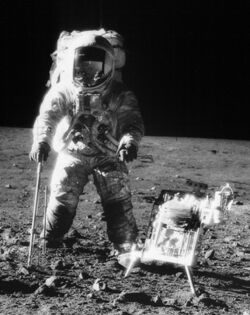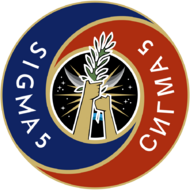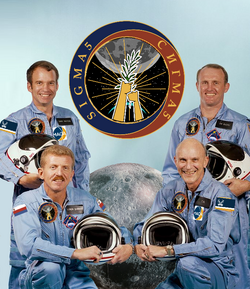Sigma 5
 Lukas Brennzer next to the Scientific Instrument Module on the Moon, May 6, 1980, photographed by Aleksandr Sahalinov | |
| Mission type | Crewed lunar landing |
|---|---|
| Operator | |
| COSPAR ID | CSM: 1980-023A LM: 1980-023B |
| SATCAT no. | CSM: 13106 LM: 13108 |
| Mission duration | 11 days, 6 hours, 46 minutes, 11 seconds |
| Spacecraft properties | |
| Spacecraft |
|
| Manufacturer |
|
| Launch mass | 10,869 pounds (4,930 kg) |
| Landing mass | 12,054 pounds (5,468 kg) |
| Crew | |
| Crew size | 4 |
| Members |
|
| Callsign |
|
| EVAs | 1 in cislunar space to retrieve film cassettes and 3 on the lunar surface |
| EVA duration | 1 h 23 min 42 s (spacewalk) |
| Start of mission | |
| Launch date | May 2, 1980, 12:10:00 UTC |
| Rocket | Atlant-3 AT-388 |
| Launch site | TBD |
| End of mission | |
| Recovered by | CRS Wagemut |
| Landing date | May 13, 1980, 18:56:11 UTC |
| Landing site | TBD |
| Orbital parameters | |
| Reference system | Selenocentric |
| Periselene altitude | 20.7 kilometers (11.2 nmi) |
| Aposelene altitude | 105.4 kilometers (56.9 nmi) |
| Period | 1.89 hours |
| Epoch | May 5, 1980, 00:00 UTC |
| Payload | |
| Mass |
|

 Left to right: Lukas Brennzer, Georgy Cheryomushev, Walther Gählen, Aleksandr Sahalinov | |
Sigma 5 was the fifth international manned spaceflight mission of the Sigma program between the Mascyllary and Dulebian space programmes. It was the first mission that successfully landed humans on the Moon. The overarching project, and its culmination into the first lunar landing, evolved into a keen symbol of détente between the democratic and communist blocs of the Great Game and is agreed upon to mark the end of the Space Race.
The four crew members and astronauts Lukas Brennzer, Georgy Cheryomushev, Walther Gählen and Aleksandr Sahalinov launched from X on May 2, 1980 at 12:10:00 UTC with a Atlant-3 rocket, before arrving in lunar orbit three days later. While Command Module pilot Cheryomushev remained in orbit and flew the X alone, Brennzer, Gählen and Sahalinov jettisoned the Lunar Module Einigung to depart for landing on the Moon; at 13:07 UTC on May 5, 1980, Einigung touched down in the Mare Ingensis region. Five hours later, Sahalinov became the first person to step onto the lunar surface, with Brennzer and Gählen following twenty and fifty-three minutes respectively. The three astronauts spent 79 hours and 11 minutes on the surface of the Moon, collecting 29 kilograms of samples and rocks and conducting multiple scientific experiments before lifting off and returning to X again via the Einigung ascent stage. X then jettisoned Einigung and accelerated to exit lunar orbit towards Aurorum, and finally splashing down in the North Agric Ocean on May 13 and retrieved by the Mascyllary aircraft carrier CRS Wagemut after approximately 11 days in space.
The landing and Sahalinov's first step on the lunar surface was broadcasted in live TV to more than 400 million people, the largest audience to a live event broadcasted in history. While the mission was originally intended to symbolize the cooperation and technological edge of both political blocs, it also had significant scientific value whereby the surface samples returned to Earth revealed the Moon's chemical composition and the scientific experiments conducted on the Moon gathered intel about its magnetosphere, atmosphere and geology.